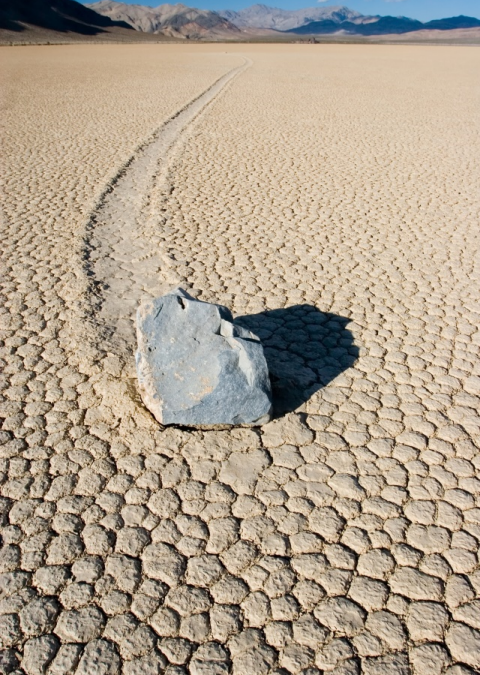3-PS2-2 Make observations and/or measurements of an object’s motion to provide evidence that a pattern can be used to predict future motion.
If you are teaching the Next Generation Science Standards and are looking for phenomena ideas, you’ve come to the right place! I like to think about phenomena as lesson starters. They are photos or videos showing an observable event in the universe and are used to get kids thinking, asking questions, and discussing their prior knowledge. For more information about using phenomena, there is a handy printable guide and video here:
https://www.nextgenscience.org/resources/phenomena
When you look at the stone in this photo, how do you think it got there? Has the stone been pushed by the wind or pulled by gravity? Has an animal or a person moved it forward without leaving any footprints? If you can’t seem to come up with an answer, you’re not alone! The mystery of this stone and many others like it has baffled scientists for almost 100 years!
This photo gives us a glimpse of a natural phenomenon called “sailing stones.” Sailing stones can be seen in a few locations in the U.S. The most famous can be found in Death Valley National Park. There, hundreds of stones, rock, and boulders dot the landscape. Their mysterious trails give evidence of their movement. No one has ever watched them move, and yet it is clear that somehow they do. They sit for years. Then suddenly a park ranger would find that they had drifted to new locations. Sometimes they move only a few inches and in other cases thousands of feet!
Scientists set up an experiment to figure out how these stones move, and here is what they found: Every winter, several inches of rain freeze creating a pond of ice in an area of Death Valley known as the Racetrack Playa. Stones, rocks, and boulders dot the pond’s surface. As the sun warms the ice, it begins to crack. The thin sheet of ice covering the lake bed is only about the thickness of three quarters stacked on each other. As it breaks up under the sun, pieces of ice accumulate behind the rocks. Working together, the wind and ice gently push the rocks forward along the soft, moist ground. Eventually, the water evaporates. The ground dries out. The trails are visible for all to see.
******************************************************************
This information is from the text: Solving the Mystery of Sailing Stones by Michelle Negron Bueno. Solving the Mystery of Sailing Stones is found in, StarrMatica Texts: Science Your Way, a collection of informational texts written specifically to address every K-5 NGSS Performance Expectation. All texts in the collection begin with a phenomenon photo and are written at six different Lexile levels, so all students can read the same content at their reading level. You can find out more about StarrMatica Texts: Science Your Way here: http://www.starrmatica.com/index.php?/main/texts


